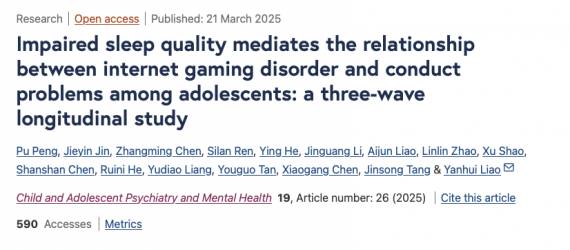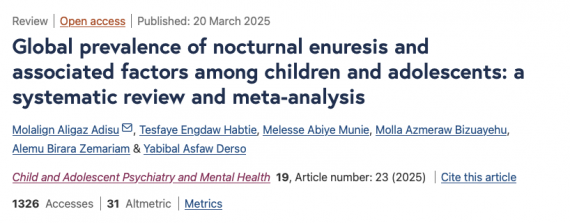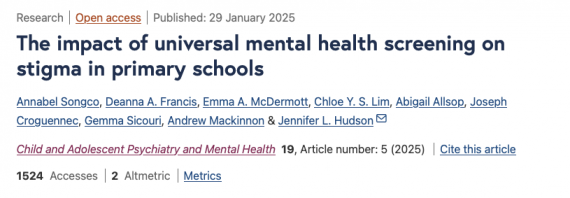CAPMH Corner (Updated Jun 2025)
By: Lakshmi Sravanti, India, Deputy Editor, CAPMH.
Child and Adolescent Psychiatry and Mental Health (CAPMH) is the official IACAPAP Journal. The "CAPMH Corner" of the Jun 2025 issue of IACAPAP Bulletin summarizes the following three studies recently published in CAPMH – Impaired sleep quality mediates the relationship between internet gaming disorder and conduct problems among adolescents: a three-wave longitudinal study (Peng et al., 2025), Global prevalence of nocturnal enuresis and associated factors among children and adolescents: a systematic review and meta-analysis (Adisu et al., 2025), and The impact of universal mental health screening on stigma in primary schools (Songco et al., 2025).
Peng et al., (2025) discuss the growing concern of Internet Gaming Disorder (IGD) among adolescents and highlight the need to examine how sex and developmental stage influence the relationship between IGD, conduct problems, and impaired sleep quality.
The team sets out to conduct a three-wave longitudinal school-based study among Chinese adolescents (n = 20137), aiming to test the following hypotheses: (1) Is IGD an independent risk fac¬tor for conduct problems among adolescents? (2) Does impaired sleep quality mediate the relationship between IGD and conduct problems? (3) Is there a difference in the association between IGD, conduct problems, and impaired sleep quality across sex and developmental stages? Internet Gaming Disorder (IGD) was assessed at baseline (T1) using the nine-item Internet Gaming Disorder Scale – Short Form (IGDS9-SF), conduct problems were assessed using the conduct problems subscale from the Strengths and Difficulties Questionnaire (SDQ) at T1, T2, and T3, and impaired sleep quality was measured at T1 and T2 using the Pittsburgh Sleep Quality Index (PSQI). They use descriptive statistics, Chi-square tests for categorical variables and Student’s t-tests for continuous variables, logistic regression models mediation analysis and multiple-group analyses for data analysis.
Initially, 20,137 seventh and tenth-grade students were enrolled in the study. At the first follow-up (T2), 15,061 students participated (response rate: 75%), and at the second follow-up (T3), 14,706 students completed the survey (response rate: 73%). Approximately 85% of the adolescents participated in at least one follow-up (n = 16,982), and 63% (n = 12,785) participated in all three waves. The prevalence of conduct problems decreased over time, from 9.0% at T1 to 6.5% at T2 and 6.0% at T3. Logistic regression analyses revealed that both cross-sectional and longitudinal associations between IGD and conduct problems remained significant after adjusting for baseline covariates. The mediation analysis revealed both direct and indirect effects of IGD on conduct problems. The direct effect of IGD on conduct problems was 0.041 (95% CI = 0.020-0.062), and the indirect effect via impaired sleep quality was also significant (β=0.010, 95% CI=0.006-0.014). IGD had significant direct and indirect effects on conduct problems in both genders, with stronger effects in boys (total effect = 0.061, direct effect = 0.051) compared to girls (total effect = 0.037, direct effect = 0.029). However, sleep quality mediated a larger proportion of the effect in girls (21.6%) than boys (16.4%). Both early and late adolescents showed similar total effects, but sleep quality played a greater mediating role in early adolescence (23.5%) than in late adolescence (10%), suggesting its stronger influence during early adolescence.
The authors acknowledge the study’s strengths – namely, a large sample size and a robust three-wave longitudinal design; and its limitations – including reliance on self-reported measures; limited generalizability due to the exclusive focus on Chinese adolescents; the omission of other potential mediators such as emotion regulation, family dysfunction, and cyberbullying; and the observational design, which limits causal inference and does not rule out reverse causation. They conclude by recommending that future research address these limitations by incorporating objective measures, diverse populations, and additional mediators to better understand the mechanisms linking IGD to conduct problems.
Adisu et al. (2025) highlight that nocturnal enuresis (NE) is a hidden public health concern that warrants greater attention and emphasize the need to understand its contributing factors for effective management. They carry out a systematic review and meta-analysis following PRISMA guidelines, after registering with PROSPERO, to provide a comprehensive overview of the global prevalence of nocturnal enuresis and its associated factors.
The team includes observational studies (longitudinal, cross-sectional, and case-control) conducted among children and adolescents aged 5 to 18, published in English and available electronically. Using an adapted PEOS framework, they develop review questions focused on the global prevalence of NE and its associated factors. They search – PubMed Central, Cochrane Library, Web of Science, Scopus, and Google Scholar, using defined MeSH and free-text terms with Boolean operators. Three independent reviewers assess the study quality using a modified Newcastle-Ottawa Scale. They calculate the prevalence estimates with corresponding standard errors using the formulas p = r/n and SE = √p(1 − p)/n, where p is the proportion, r is the number of children with nocturnal enuresis, and n is the sample size. They employ a random-effects model to pool prevalence with 95% confidence intervals, using a significance threshold of p < 0.05. They assess heterogeneity using the I² index and Cochran’s Q test, with I² values interpreted as low (<25%), moderate (25–50%), or high (>75%). They carry out subgroup analyses by year of publication and continent to explore sources of heterogeneity, and perform sensitivity analysis to evaluate the influence of individual studies. They examine publication bias through funnel plot symmetry, Egger’s test, and trim-and-fill methods.
A comprehensive meta-analysis of 127 studies involving 445,242 individuals across 39 countries and six continents revealed a pooled prevalence of NE among children and adolescents at 7.2% (95% CI: 6.2–8.1%), with no heterogeneity (I² = 0%). The majority of studies (117) were cross-sectional, with 113 examining both primary and secondary NE. Subgroup analysis showed higher prevalence in Africa (12%) and Australia (14%) compared to Asia (6%) and Europe (8%), while prevalence by publication year was highest post-2019 (11%). Nearly half the participants were female (48.7%), with 60% of NE cases being male and 71.6% classified as primary NE. Publication bias was detected (Egger’s test p = 0.000), but trim-and-fill analysis showed minimal effect on the pooled estimate. Factors significantly associated with NE included family history (pooled AOR 1.49, 95% CI: 1.26–1.71), positive history of urinary tract infection (AOR 3.89, 95% CI: 2.93–4.46), stressful life events (AOR 1.90, 95% CI: 1.75–2.05), and male sex (AOR 1.63, 95% CI: 1.31–1.94), while being first-born was associated with a lower risk (AOR 0.5, 95% CI: 0.37–0.62). Sensitivity analyses confirmed the robustness of the results, indicating no influential outliers across studies.
The authors acknowledge strengths of their study – the first systematic review of global nocturnal enuresis prevalence among children and adolescents, inclusion of studies without date restrictions to maximize coverage, and the homogeneity of findings which enhances generalizability. They also highlight the limitations including variability in assessment criteria across regions and challenges in accessing full-length articles for some studies. They conclude that nocturnal enuresis is associated with significant risk factors including family history, urinary tract infections, stressful events, birth order, and sex. They emphasize the need for early screening and individualized interventions, and recommend future research focus on targeted strategies and the long-term psychological impacts of the condition.
Songco et al., (2025) discuss common mental health disorders in children, particularly anxiety and depressive disorders, and their impact on children's social, emotional, and educational development. They emphasize the importance of universal screening and school-based interventions. The authors highlight mental health stigma and low mental health literacy among children and parents as key barriers to accessing care, and they examine the impact of assessing mental health symptoms on stigma in primary school children.
The authors conduct a cluster randomised controlled trial involving 798 primary school children aged 8–13 years from across Australia, with schools randomly assigned to either a monitor A or monitor B group, using stratification based on socioeconomic status, geographic location, and school gender composition. Participants completed assessments at baseline, 6-week, and 12-week follow-ups using the Paediatric Self-Stigmatization Scale (PaedS) and the Revised Child Anxiety and Depression Scale (RCADS-25). Mixed-model repeated measures (MMRM) analyses examined changes in overall and subtypes of stigma (societal devaluation, personal rejection, self-stigma, secrecy), anxiety, and depression over time, accounting for school-level clustering.
They report no overall group differences in stigma (F[1, 3.039] = 0.094, p = 0.277, 95% CI [− 0.131, 0.319]). However, stigma significantly decreased at 12 weeks compared to baseline, with no change at 6 weeks. A significant group × time interaction showed that stigma decreased in the Monitor A group but increased in the Monitor B group at both 6 and 12 weeks. There was no significant group difference or interaction effect in concerns about societal devaluation (F[1, 3.247] = 0.014, p = 0.937, 95% CI [− 0.499, 0.528]). However, a significant time effect showed reduced concerns from baseline to both 6 and 12 weeks, even after adjusting for multiple comparisons. There were no significant group differences in concerns around personal rejection, self-stigma, secrecy, anxiety, or depression. A small decrease in personal rejection at 6 weeks (F[2, 513.279] = − 0.053, p = 0.034, 95% CI [− 0.102, − 0.004]), would not remain significant if adjusted for multiple comparisons. Concerns around self-stigma and secrecy significantly increased over time, with group differences in the magnitude of increase; however, only some of these interaction effects remained significant after correction. Anxiety showed a significant group × time interaction, with a greater reduction in the monitor A group (F[1, 346.525] = − 1.735, p = 0.010, 95% CI [− 3.059, − 0.411), while depression showed no significant changes over time or between groups (F[1, 1.705] = − 0.396, p = 0.557, 95% CI[− 3.200, 2.409).
The team acknowledges strengths of their study – being the first cluster randomised controlled trial to examine the impact of universal mental health screening on stigma in primary school children, exploring multiple dimensions of stigma, employing a unique study design with important implications for school-based interventions, and including follow-up assessments at 6 and 12 weeks. They also highlight limitations including a small and unbalanced number of participating schools, challenges in recruitment due to post-COVID-19 constraints, and limited generalisability due to sampling bias, as most participating schools were Independent schools from New South Wales. They conclude by emphasizing that while universal mental health checks in primary schools may reduce stigma over time, caution is warranted as such assessments could also inadvertently increase self-stigma and secrecy among children. They recommend future research to refine study designs, ensure inclusivity, improve measurement methods, and engage diverse school populations and parents to better understand and mitigate potential harms of school-based mental health screening.
REFERENCES:
- Adisu, M.A., Habtie, T.E., Munie, M.A. etal. Global prevalence of nocturnal enuresis and associated factors among children and adolescents: a systematic review and meta-analysis. Child Adolesc Psychiatry Ment Health19, 23 (2025). https://doi.org/10.1186/s13034-025-00880-x.
- Peng, P., Jin, J., Chen, Z. etal. Impaired sleep quality mediates the relationship between internet gaming disorder and conduct problems among adolescents: a three-wave longitudinal study. Child Adolesc Psychiatry Ment Health19, 26 (2025). https://doi.org/10.1186/s13034-025-00889-2.
- Songco, A., Francis, D.A., McDermott, E.A. et al. The impact of universal mental health screening on stigma in primary schools. Child Adolesc Psychiatry Ment Health19, 5 (2025). https://doi.org/10.1186/s13034-024-00854-5.




